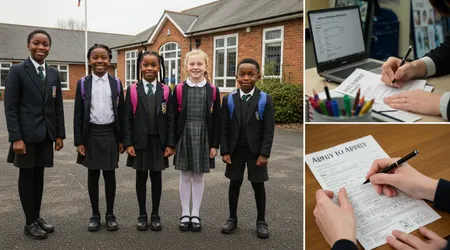School Uniform Grants UK: How to Apply

The cost of school uniforms can be a significant financial burden for many families. This is where School Uniform Grants UK comes in.
These grants are designed to help low-income families cover the cost of school clothing and equipment. They are a crucial support system.
The UK government recognizes that a proper uniform is essential. It helps create a sense of belonging and community. It removes the pressure to wear expensive fashion. This ensures a level playing field for all students.
However, the costs can quickly add up. A full uniform, including PE kit and shoes, can cost hundreds of pounds. This is why understanding School Uniform Grants UK is so important. These grants can be a vital financial lifeline.
The grants are not managed centrally. Each council sets its own rules. The eligibility criteria and grant amounts vary widely. This can make the process confusing for parents.
The system requires parents to be proactive. They need to research their specific local council. They must know the application deadlines. This is the key to successfully securing a School Uniform Grants UK.
Families in Scotland, Northern Ireland, and Wales have different systems. While the name may differ, the purpose is the same. The goal is always to help families in need.
Who is Eligible for a Grant?
Eligibility for a School Uniform Grants UK is primarily based on income. Most councils require parents to receive certain benefits. This ensures the grants go to those who need them most.
Common qualifying benefits include Universal Credit, Jobseeker’s Allowance, and Child Tax Credit. Receiving free school meals is also a strong indicator of eligibility.
The rules are not identical everywhere. For example, a family might qualify in one borough but not another. This is a challenge of the current system for School Uniform Grants UK.
++ Free Prescriptions and Healthcare Support in the UK
Some councils have strict income thresholds. Others consider individual family circumstances. It is crucial to check your local council’s website for specific details.
Families must provide evidence of their income. They must also prove their child attends a particular school. This is a standard part of the application process for School Uniform Grants UK.
It’s not just about benefits. Sometimes, even if you don’t receive these, you might qualify. It is worth investigating all possibilities. A simple check can make a big difference.

How to Apply for a Grant
Applying for a School Uniform Grants UK is a straightforward process. The first step is to find your local council. Their website will have a dedicated section for education grants.
The application form is typically available online. You will need to fill out your personal details. You will need to provide information about your child and their school.
You must be prepared to submit supporting documents. This includes proof of benefits and your child’s enrolment. A clear photo or scan of these documents is usually sufficient.
Deadlines are critically important. Applications often open in July or August. They close before the start of the new school year. Missing the deadline means missing out on the grant.
Some councils use the Free School Meals application. You can apply for both at the same time. This streamlines the process and reduces paperwork.
Also read: Pension Credit Explained: How to Maximise Your Benefits UK
According to a 2024 report by the Education Policy Institute (EPI), only 45% of eligible families successfully applied for and received a school uniform grant. This highlights the need for better public awareness.
What to Expect After You Apply
After submitting your application for a School Uniform Grants UK, you will need to wait for a decision. The council will review your information. They will verify your eligibility. This usually takes a few weeks.
If your application is successful, you will receive a notification. The grant money is usually paid directly into your bank account. The payment is a lump sum.
The amount of money varies. It can range from £15 to over £150 per child. This depends entirely on your local council.
The money is yours to spend. There are no restrictions on where you buy the uniform. You can shop at a supermarket or a specialist school outfitter.
Read more: Jobseeker’s Allowance vs. Universal Credit: Key Differences Explained
What about families who are not approved? They can often appeal the decision. The council website will have information on the appeal process. It is worth pursuing.
A family’s financial situation can change. If you become eligible for benefits later, you might still qualify. You can always check with your local council for a late application.
Examples of Grant Schemes

Let’s look at some real-world examples of School Uniform Grants UK. A council in Greater London might offer £80 per primary school child. Their application window is from July to October.
In Scotland, the system is more consistent. The Scottish Government provides a School Clothing Grant. The grant amount is standardized across the country. It is currently £120 for each primary and secondary pupil.
Wales has its own Pupil Development Grant. It is a slightly different program. It provides money for uniforms and other school-related costs. The grant amount is generous.
These examples show the variability. There is no one-size-fits-all approach. The system is like a patchwork quilt. Each patch represents a different council with its own rules.
This variability can make finding information challenging. But with a bit of research, it is manageable. Parents can easily navigate the system.
A simple search for “School Uniform Grants UK” plus your council’s name will get you started. It is the most effective way to find the right information.
Beyond the Grants: Other Help Available
What happens if you are not eligible for a grant? There are still other options. Many schools run second-hand uniform shops. These offer low-cost, high-quality items.
Charitable organizations also help. They provide uniform vouchers or clothing. This support is invaluable for families facing hardship.
Online community groups can be a great resource. Parents often swap or give away uniforms. It’s a fantastic way to save money and reduce waste.
Can we do more as a society? What if all schools had a mandatory second-hand uniform policy? Would that alleviate the burden on parents? It’s a thought-provoking question.
Some schools have partnered with charities. This makes it easier for families to get help. It is a proactive and empathetic approach.
The effort to make school affordable is ongoing. Grants are a big part of it. But community support is just as important.
| Region | Grant Name | Typical Amount | How to Apply |
| England | Varies by council | £15 to £150+ | Via local council website |
| Scotland | School Clothing Grant | £120 (standardized) | Via local council website |
| Wales | Pupil Development Grant | Varies (often higher) | Via local council website |
| Northern Ireland | Uniform Allowance | Varies | Via NI Direct website |
This table shows the clear differences across the UK. It is a helpful starting point for any family.
Frequently Asked Questions
1. Who is eligible for a School Uniform Grant in the UK?
Eligibility is primarily based on your income and whether you receive certain benefits, such as Universal Credit or Child Tax Credit. Your local council will have specific criteria that you need to meet.
2. How much money will I receive from a grant?
The grant amount varies significantly by council in England, but it is a fixed amount in Scotland (£120). In other regions like Wales and Northern Ireland, the amount also varies.
3. What is the deadline to apply for a grant?
Application deadlines are set by each local council and are often in the summer months, typically before the start of the new school year in September. It is essential to check your council’s website for the specific closing date.
4. Can I use the grant money anywhere?
Yes, the money is typically paid directly to you. There are no restrictions on where you purchase the uniform, allowing you to find the best deals at supermarkets, department stores, or specialist uniform shops.
5. What should I do if my application is rejected?
If your application is rejected, you may have the option to appeal the decision. Your local council’s website should provide information on their appeals process, which can be helpful if your circumstances were not fully considered.
